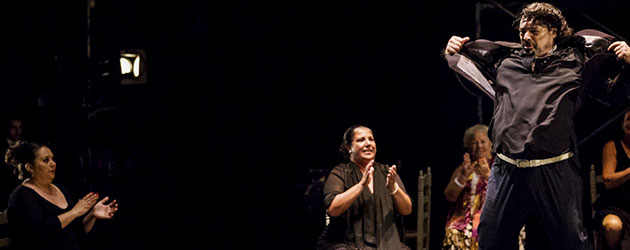Text: Sara Arguijo
Photos: Oscar Romero / La Bienal
Antonio Canales Artistic director: Ángel Rojas. Interpreters: Antonio Moya, Carmen Ledesma, David El Galli, El Maera, El Polito, Herminia Borja, Luis Peña, Mari Peña, Paco Iglesias, Pastora de los Reyes, Pol Vaquero. Teatro Lope de Vega – Sunday, September 25th, 2016
Triana forever
I could try to explain to people outside Seville reading this, what Triana was and is, and what it means to be part of a neighborhood in this city of independent areas. Resort to its undeniable title as the birthplace of flamenco and the more or less corny images of purity and the essence that still surrounds those who live on the left bank of the Guadalquivir. But it would be a slanted and surely unfair reading because, in the end, as Antonio Canales says in the handbill of «Trianero», the show he debuted this Sunday at the Bienal, «All Triana can fit into a simple flower-pot, and the Guadalquivir river in a clay jug…but at the same time, they are vast and extensive for a hundred million arms that wish to capture them». Who will be brave enough to try?
What can be said, is that Canales' work is a good starting-point for understanding the complexity, the contrasts and depth of a neighborhood often reduced to the size of a postcard. At least for those of us delving into the vision of those represented. As Milan Kundera would say, what is culture but the memory of a community.
In other words, with all the theatrical weight and staging of the dancer's work, possibly over the top at the Lope de Vega theater, «Trianero» is a simple example of the most natural facet in which flamenco is developed and expanded. That which is empoyed by this artform as a means of dialoguing, debaing, showing affection, rebelling, freeing, sharing…expressing life.
In this sense, Canales comes off as a spiritual guide to try give back to his people the desire to come together in compás, even knowing that not everything is as pretty as «Todo es de Color». And he does so letting them be themselves, developing. The communion of sincere affection was the true star of the night.
The disparate voices of David el Galli, full and superb in martinetes and fandangos, Herminia Borja, raw and rebellious in the bulerías song for Canales, and Mari Peña, temperamental and brave in tientos and throughout the show, all came together in a common point of encounter. And the inspired guitars of Antonio Moya and Paco Iglesias were thoroughly enjoyable. The sincerity and generosity of Luis Peña and El Maera. The contrasting strength of El Polito and Pol Vaquero in their roles as executioners. And of course, the way the Seville man danced siguiriyas, soleá and tangos with his particular style that never forgets feeling or pain or laughter as required by each of the forms. What hands, what hips and what spontaneity.
Of course, if there must be winners, they were Carmen Ledesma and Pastora de los Reyes. In the first place, because of their charisma and magnetism, they gave a lesson in absolute commitment, and offered the tranquility and knowledge of people who know that satisfaction is forthcoming when you do things for pleasure, for enjoyment. And then, because Ledesma is all surprises, purely visceral affirmation. In siguiriyas this dancer raises an arm, opens her hand and suddenly paralyzes all angst. In bulerías, with a simple hip movement, she reminds us why we're in this world. What a joy to see her work with castanets!
And then there's Pastora, mother of the artist, who in her stage debut (many flamenco fans already admired her thanks to the videos Canales puts up on Facebook), triggered non-stop shouts of «ole!» Her humility, her natural gracie, her self-assurance, the way she sang sevillanas and moved to bulerías would warrant all these words just for her alone. Because like it or not, we are all moved when we are kissed and embraced with the warmth this woman offers.
